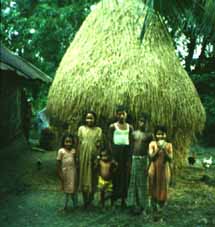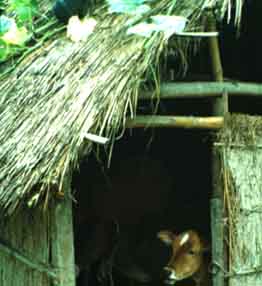 When I first went out of the capital city into the countryside, it seemed that a lot people must be living in Smurf huts. My heart went out to them, because it seemed like there wasn’t enough room to even lie down. Then somebody kindly informed me that those were in fact haystacks, not houses. They set a bamboo pole in the ground, then pile rice straw around it in a way that sheds rainwater. The cows eat it. The house in the picture above is actually off to the left. The kids insisted on being in the picture.
When I first went out of the capital city into the countryside, it seemed that a lot people must be living in Smurf huts. My heart went out to them, because it seemed like there wasn’t enough room to even lie down. Then somebody kindly informed me that those were in fact haystacks, not houses. They set a bamboo pole in the ground, then pile rice straw around it in a way that sheds rainwater. The cows eat it. The house in the picture above is actually off to the left. The kids insisted on being in the picture.
 My wife and I spent the first three months we were there studying the Bengali language. We hired a babysitter to look after our one-year-old daughter during classes. One day we visited our babysitter’s “bari,” or village. The men were all out working the fields so only the women and children were there at the time.
My wife and I spent the first three months we were there studying the Bengali language. We hired a babysitter to look after our one-year-old daughter during classes. One day we visited our babysitter’s “bari,” or village. The men were all out working the fields so only the women and children were there at the time.The house walls here were adobe, with a thatched roof. Having a corrugated metal roof is something of a status symbol, and no doubt it lasts longer than the 3 or so years a thatch roof lasts. On the other hand, thatch keeps houses much cooler because it insulates from the hot sun. Most of the time house walls are made out of split, and then woven bamboo hung on sturdy bamboo poles. I know it doesn’t sound very strong, but those houses survive hurricanes.
That is not to say that everybody in Bangladesh enjoys good housing. Some poor people live in what amounts to not much more than a cardboard box. This picture of a severe flood is near a construction site.
 A hurricane has dumped a huge amount of water. The hurricane is gone, and the people have thrown the wet clothing and bedding on the roof to dry in the sun. The big problem is that it might take a couple of weeks for the water to recede. In the mean time, they are living on stacks of bricks.
A hurricane has dumped a huge amount of water. The hurricane is gone, and the people have thrown the wet clothing and bedding on the roof to dry in the sun. The big problem is that it might take a couple of weeks for the water to recede. In the mean time, they are living on stacks of bricks.
The great danger to the kid is not that he would fall in the water (his mother is actually directly behind him, holding one of the pans). Ironically, the problem is finding drinking water. In any country--industrialized or not-- flood water is not safe to drink. The usual sources of clean water are knocked out . Boiling the water will make it safe, but many people in Bangladesh can’t afford the extra fuel. MCC, the organization I worked with, distributes water purification tablets, emergency food, blankets and other things to tide people over. Because MCC has been in Bangladesh many years—not just during disasters but always doing agriculture extension, job creation, medical programs, co-op forming etc.--they are poised to jump into relief work quickly and effectively when catastrophes does strike.
 On a lighter note, here is a picture of a barn. One of the recurring themes is that nothing is wasted. Not even the sunlight falling on this thatch roof. Squash vines are trained to climb up onto roofs and spread out and soak up the sun. Squash vines are also trained out onto trellises over ponds, where the fish seem to prefer the shade.
On a lighter note, here is a picture of a barn. One of the recurring themes is that nothing is wasted. Not even the sunlight falling on this thatch roof. Squash vines are trained to climb up onto roofs and spread out and soak up the sun. Squash vines are also trained out onto trellises over ponds, where the fish seem to prefer the shade.
